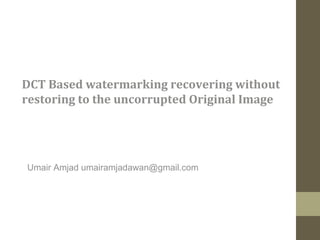
DCT based Watermarking technique
- 1. DCT Based watermarking recovering without restoring to the uncorrupted Original Image Umair Amjad umairamjadawan@gmail.com
- 2. Agenda Watermark embedding Watermark detection DCT-basedWatermark Recovering without Resorting to the Uncorrupted Original Image A. Piva, M. Barni, F. Bartolini, V. Cappellini Dipartimento di Ingegneria Elettronica Universit`a di Firenze via S. Marta 3, 50139, Firenze, Italy e-mail piva@cosimo.die.unifi.it
- 3. Watermark Embedding Read image. Lets say, I. DCT transform is applied. DCT coefficients are reordered into a zigzag scan. It is now impossible for the decoder to determine the position of the coefficients with the largest magnitude, since non-marked image is no longer available. T = {t1, t2, . . . . . . , tL, tL+1, . . . . . . , tL+M} To get perceptual invisibility we skipped first L coefficients. Now, watermark X = {x1, x2, . . . . . . , xM} (choose among pseudo-random sequences) is embedded in the last M numbers, to obtain a new vector. T’ = {t1, t2, . . . . . . , tL, t’L+1, . . . . . . , t’L+M} According to the rule: t’L+i = tL+i + α |tL+i| xi Where i = 1, . . . . . , M Now the vector T’ is inserted in the inverse zigzag scan and the inverse DCT algorithm is performed, obtaining the watermarked image I’.
- 4. Watermark Detection Read watermarked image. Lets say I*. DCT transform is applied. Perform zigzag scan. Now coefficient (L+1)th to (L+M)th are selected to generate a vector. T* = {t*L+1, t*L+2,. . . . . . , t*L+M} The correlation between the corrupted coefficients T*, and the mark itself is taken as a measure of the mark presence. For this we generate 1000 random fake watermarks. Correlation is computed for each of the marks and that with the largest correlation is assumed to be the one really present in the image.
- 5. Original Image Waterwark Image
- 6. Original Image Waterwark Image
